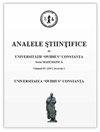有序半群中区间的和与积
IF 0.7
4区 数学
Q2 MATHEMATICS
Analele Stiintifice Ale Universitatii Ovidius Constanta-Seria Matematica
Pub Date : 2021-06-01
DOI:10.2478/auom-2021-0025
引用次数: 2
摘要
摘要:我们给出了一个简单的例子,对于有序半群本文章由计算机程序翻译,如有差异,请以英文原文为准。
Sums and products of intervals in ordered semigroups
Abstract We show a simple example for ordered semigroup 𝕊 = 𝕊 (+,⩽) that 𝕊 ⊆ℝ (ℝ denotes the real line) and ]a, b[ + ]c, d[ = ]a + c, b + d[ for all a, b, c, d ∈ 𝕊 such that a < b and c < d, but the intervals are no translation invariant, that is, the equation c +]a, b[ = ]c + a, c + b[ is not always fulfilled for all elements a, b, c ∈ 𝕊 such that a < b. The multiplicative version of the above example is shown too. The product of open intervals in the ordered ring of all integers (denoted by ℤ) is also investigated. Let Ix := {1, 2, . . ., x} for all x ∈ ℤ+ and defined the function g : ℤ+ → ℤ+ by g(x):=max{ y∈ℤ+|Iy⊆Ix⋅Ix } g\left( x \right): = \max \left\{ {y \in {\mathbb{Z}_ + }|{I_y} \subseteq {I_x} \cdot {I_x}} \right\} for all x ∈ ℤ+. We give the function g implicitly using the famous Theorem of Chebishev. Finally, we formulate some questions concerning the above topics.
求助全文
通过发布文献求助,成功后即可免费获取论文全文。
去求助
来源期刊

Analele Stiintifice Ale Universitatii Ovidius Constanta-Seria Matematica
MATHEMATICS, APPLIED-MATHEMATICS
CiteScore
1.30
自引率
0.00%
发文量
15
审稿时长
6-12 weeks
期刊介绍:
This journal is founded by Mirela Stefanescu and Silviu Sburlan in 1993 and is devoted to pure and applied mathematics. Published by Faculty of Mathematics and Computer Science, Ovidius University, Constanta, Romania.
 求助内容:
求助内容: 应助结果提醒方式:
应助结果提醒方式:


